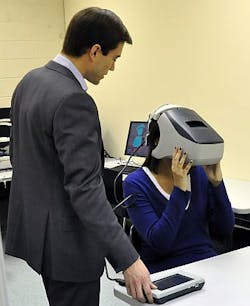Army researchers buy eye-tracking system to diagnose traumatic brain injuries in deployed warfighters
ABERDEEN PROVING GROUND, Md., 13 Sept. 2012. U.S. Army head-trauma experts plan to buy several a portable eye-tracking device designed for use in the field to check soldiers for possible traumatic brain injuries caused by close proximity to explosions, accidents, or other kinds of blows to the head.
The Army Contracting Command at Aberdeen Proving Ground, Md., announced plans late last week to purchase 10 Eye-TRAC Systems, 10 laptop computers, and training from Sync-Think Inc. in Boston under terms of a sole-source contract.
Eye-TRAC stands for Eye-Tracking Rapid Attention Computation, and has the potential to improve ways of detecting traumatic brain injuries, or TBI, in deployed warfighters who have been subject to head-injury events such as detonations of improvised explosive devices (IEDs).
The Sync Think Eye-TRAC device uses hooded goggles and a hand-held peripheral to track eye movements with two high-speed cameras as the patient follows a moving target on a screen.
"It's a relatively simple test, but the device uses complex algorithms to quantify how well a subject can follow, and synchronize with, the target," says Kevin Coppersmith, Sync Think CEO, in a story headlined Eyes could provide windows to traumatic brain injury that was posted earlier this year on the U.S. Army Website.
"We're measuring attention performance, a subject's focus, Coppersmith says. "We believe eye-movement control provides a window to the brain and can be a reliable indicator of brain health." Desktop eye-tracking devices have been available for a decade, but Eye-TRAC would bring the technology closer to deployed soldiers who suffer blast injuries, Coppersmith points out.
The amount of the Army contract to Sync Think has yet to be negotiated. The Eye-TRAC system is the only device that will satisfy Army requirements, and Sync Think is its only responsible supplier, Army officials say.
The Eye-TRAC system can measure change in cognitive function of warfighters who may be suffering from brain injuries. The device performs cognition and motor timing diagnosis using smooth eye pursuit analysis, helps improving cognition and motor timing, and provides cognition and motor timing diagnosis and training.
Follow Military & Aerospace Electronics and Avionics Intelligence news updates on Twitter
